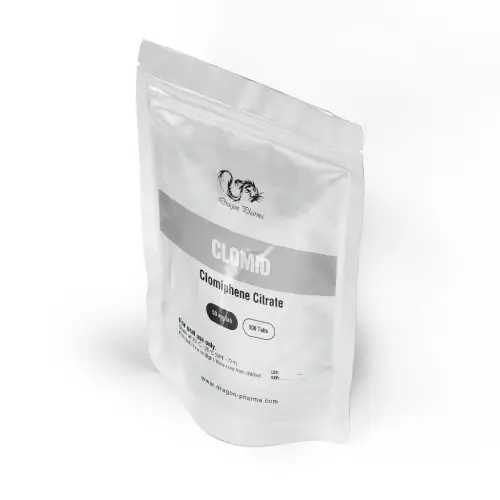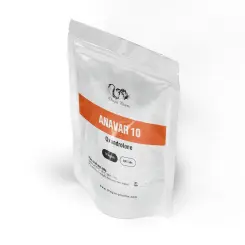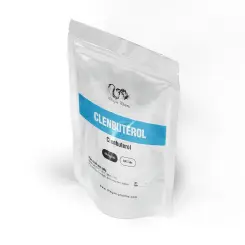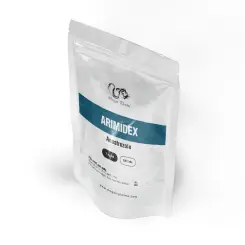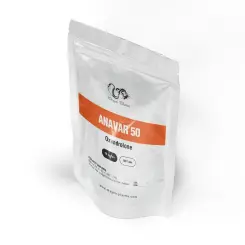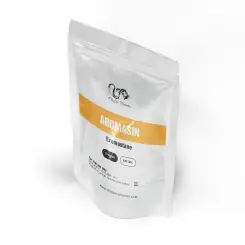Clomid
- Reboots HPTA for quick testosterone recovery.
- Prevents muscle loss and maintains strength gains.
- Reduces estrogen-related side effects like gynecomastia.
- Supports overall hormonal balance and well-being.
What is Clomiphene Citrate?
Clomiphene Citrate, branded as Clomid, is a selective estrogen receptor modulator (SERM) classified as an oral medication in this 50 mg/tab, 100-tab pack from Dragon Pharma. Originally developed for fertility treatment in women, it's widely used in bodybuilding for post-cycle therapy (PCT) to stimulate natural testosterone production. As an oral drug, it has minimal hepatotoxicity and no aromatization, making it a safe choice for hormone recovery protocols when used responsibly.
Mechanism of Action Clomid
Clomiphene Citrate binds to estrogen receptors in the hypothalamus and pituitary gland, blocking estrogen's negative feedback on gonadotropin release. This stimulates luteinizing hormone (LH) and follicle-stimulating hormone (FSH) production, increasing testicular testosterone output. Users experience restored hormone levels, reduced estrogenic effects, and preserved muscle mass within weeks of starting PCT.
With a half-life of approximately 5-7 days, Clomid provides sustained action with daily dosing. It selectively modulates estrogen receptors without agonist activity in most tissues, avoiding estrogenic side effects like water retention or gynecomastia. What doesn't happen: no direct androgenic effects, no significant liver strain at standard doses, and no further suppression of natural hormones, making it ideal for PCT.
Mild side effects like mood swings or visual disturbances may occur, manageable with proper dosing and monitoring.
How It Works & Key Benefits
Clomid excels for bodybuilders completing anabolic steroid cycles, requiring bloodwork and a structured PCT plan to maximize hormone recovery and preserve gains.
- Stimulates natural testosterone production for rapid recovery.
- Prevents gynecomastia and estrogen rebound post-cycle.
- Preserves muscle mass and strength gains.
- Improves mood and energy during PCT transition.
- Supports fertility and long-term hormonal balance.
- Stacks effectively with other PCT agents for synergy.
Who It's For & Product Specifications
Best for intermediate to advanced bodybuilders completing steroid cycles, aiming to restore natural testosterone and prevent estrogenic side effects; suitable for men. Not recommended for women (except in specific medical fertility contexts), beginners, or those with vision issues or liver conditions.
| Substance | Clomiphene Citrate |
|---|---|
| Concentration | 50 mg/tab |
| Form | Oral tablets |
| Pack Size | 100 tabs |
| Half-life | 5-7 days |
| Aromatization/Hepatic | Non-aromatizing / Minimal hepatic |
| Primary Use | PCT, hormone recovery |
| Manufacturer | Dragon Pharma |
| Brand | Clomid |
How to Use
- Dosage: 50-100 mg/day for 4-6 weeks; start high (100-150 mg for first 2 weeks) then taper to 50 mg.
- Frequency: Daily, preferably in the morning to minimize side effects.
- Cycle length: 4-6 weeks post-cycle, aligned with steroid clearance.
- Preparation/Monitoring tips: Take with water; monitor testosterone and estrogen levels via bloodwork; maintain healthy diet and sleep; use with HCG if needed for synergy.
- Results timeline: Testosterone increase in 1-2 weeks; full HPTA recovery in 4-6 weeks.
- PCT timing: Start 1-3 days after last oral steroid dose or based on ester clearance (3-4 days post-short ester, 10-14 days post-long ester); use tamoxifen or clomiphene, guided by bloodwork.
Popular Stacks
Nolvadex: Enhances estrogen blocking and HPTA recovery for comprehensive PCT.
HCG: Synergizes to stimulate testicular function during PCT.
Arimidex: Controls estrogen rebound in aggressive PCT protocols.
Cycle Support: Supports liver and lipid health during recovery.
Comparisons & Alternatives
Clomid vs Nolvadex: Clomid is stronger for LH stimulation; Nolvadex is better for preventing gynecomastia but both are often stacked for optimal PCT.
Clomid vs Enclomiphene: Clomid is a racemic mix; Enclomiphene is the active isomer with fewer estrogenic side effects but less available.
Clomid vs HCG: Clomid stimulates pituitary LH/FSH release; HCG mimics LH for direct testicular stimulation, often used together for synergy.
Side Effects & Risk Management
- Endocrine: Mood swings, hot flashes—taper dose gradually to minimize.
- Visual: Rare blurriness or floaters—monitor and discontinue if persistent.
- Cardiometabolic: Potential lipid changes—use omega-3s, monitor labs.
- Hepatic: Minimal strain—routine liver tests advised.
- Dermatologic: Rare acne—manage with skincare products like Accutane.
Review labs with a professional where lawful to ensure authenticity and disciplined dosing for safety.
Post-Cycle Therapy (PCT)
Clomid is a core PCT agent; start 1-3 days post-oral steroid or based on ester clearance (3-4 days post-short, 10-14 days post-long). Use 50-100 mg/day for 4-6 weeks, tapering down. Bloodwork guides HPTA recovery, ensuring sustained gains and hormonal balance.
FAQ
What is Clomid?
Clomid (Clomiphene Citrate) is an oral SERM for post-cycle therapy and hormone recovery; see What is Clomiphene Citrate. It restores testosterone—consult professionals for safe use.
How long does Clomid take to work?
Clomid boosts testosterone in 1-2 weeks, with full HPTA recovery in 4-6 weeks; see Results timeline. Monitor with bloodwork for optimal results.
How to take Clomid?
Take 50-100 mg daily, tapering over 4-6 weeks post-cycle; see How to Use. Align with steroid clearance—consult for personalized plans.
What is Clomid used for?
Clomid is used for PCT to restore testosterone and prevent estrogenic effects; see Key Benefits. Ideal for bodybuilders—use with professional oversight.
How long does Clomid stay in your system?
With a 5-7 day half-life, Clomid is detectable for 2-4 weeks; see Mechanism of Action. Plan PCT accordingly—consult professionals for guidance.
Related Products
- Builds lean, hard muscle without water retention.
- Enhances strength for improved training performance.
- Promotes fat loss while preserving muscle mass.
- Supports clean, sustainable gains with minimal side effects.
- Accelerates fat loss for a lean, defined look.
- Preserves muscle mass during calorie deficits.
- Boosts energy and endurance for intense workouts.
- Enhances metabolic rate for sustained fat burning.
- Eliminates estrogen-driven water retention for a defined look.
- Prevents gynecomastia, protecting cycle gains.
- Supports lean muscle retention during cutting phases.
- Enhances cycle safety with precise hormonal control.
- Builds lean, hard muscle without water retention.
- Boosts strength for superior training performance.
- Promotes fat loss while preserving muscle mass.
- Delivers clean, aesthetic gains with minimal side effects.
- Eliminates water retention for a hard, defined appearance.
- Prevents gynecomastia, protecting cycle aesthetics.
- Supports lean muscle preservation during cutting.
- Provides permanent estrogen reduction for cycle control.
